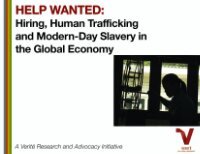By After Exploitation + Hibiscus Initiatives
There are many ways in which victim-survivors of modern slavery are criminalised, often due to activity they were forced to commit by exploiters such as drug or gang-related activity, theft, or fraud.[1] However, survivors can be at risk of criminalisation even where they are not victims of criminal exploitation. For example, survivors of adult or child sexual exploitation may face arrests or cautions for activity relating to sex work.[2] Survivors can be criminalised for reasons relating to but not caused by their exploitation. The same vulnerabilities which led to exploitation can also put people at risk of coming into contact with the criminal justice system, particularly children and women marginalised because of race, ethnicity, disability, or care experience. Victim-survivors may also be criminalised for defending themselves against their perpetrator, but this phenomenon is better understood in the United States where a number of civil rights groups actively monitor cases of this nature. More than half of women in prison or under community supervision are victim-survivors of gender-based violence or abuse, including exploitation.[3]
Criminalised survivors of modern slavery often face life-long disadvantage from receiving a criminal record. The Organisation for Security and Co-operation in Europe (OSCE), of which the UK is a member, recognises a number of disadvantages entrenched by criminalisation, including the presence of trauma, social and economic disadvantage, restricted access to the labour market and justice, social stigma and generational impacts.[4] Experts with lived experience of modern slavery told After Exploitation as part of their evidence submission to the Independent Criminal Sentencing Review 2024-25 that having a criminal record restricted their access to education, employment, and travel.
Under international law, survivors should not be punished for crime they were compelled to commit. This is called the ‘non-punishment principle’.[5] Governments also have a responsibility to identify and support victim-survivors, including those in contact with the criminal justice system.[6] In reality, the burden often falls on survivors to self-identify as survivors and share their experiences of exploitation in order to prevent their criminalisation.
After Exploitation + Hibiscus Initiatives | 2025. 14p.















